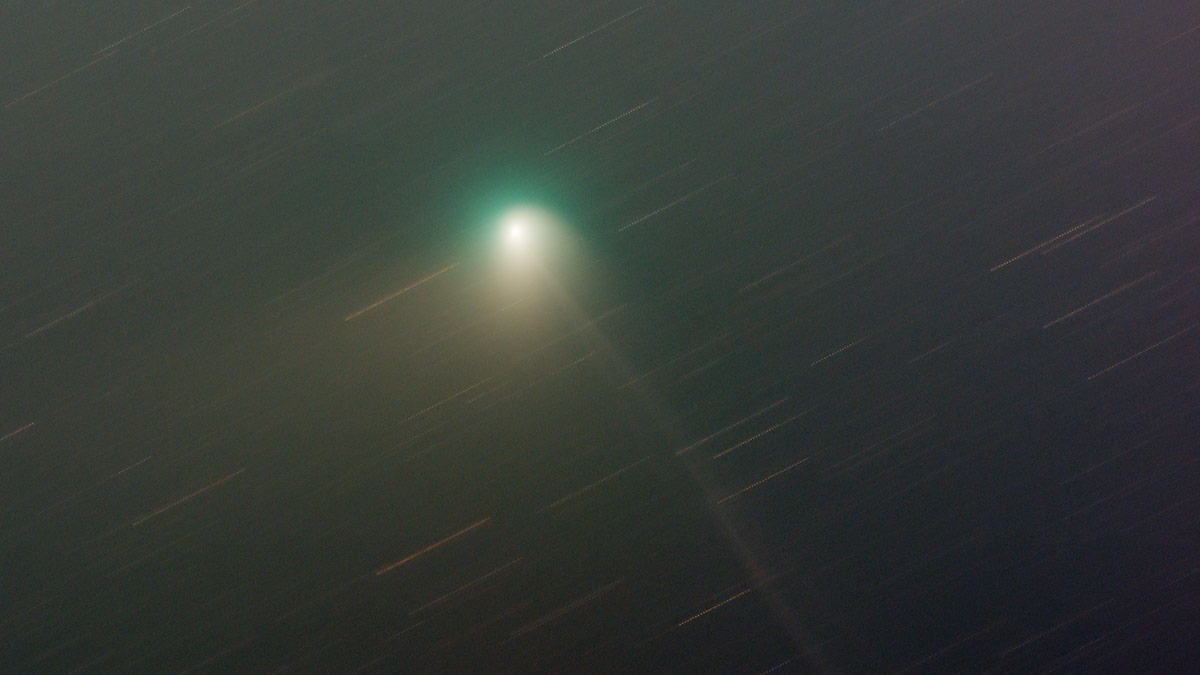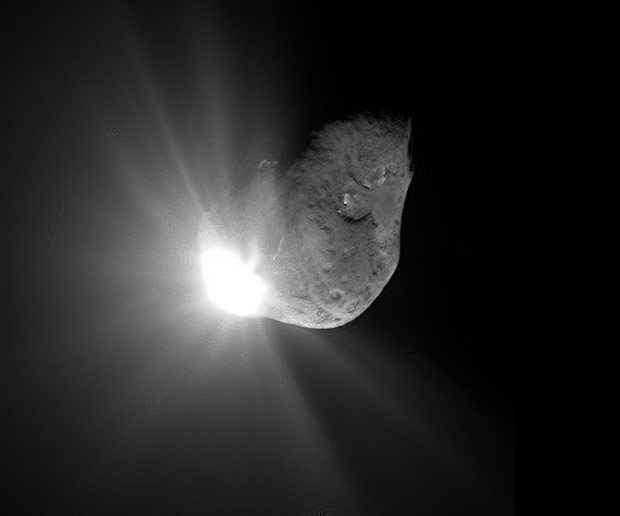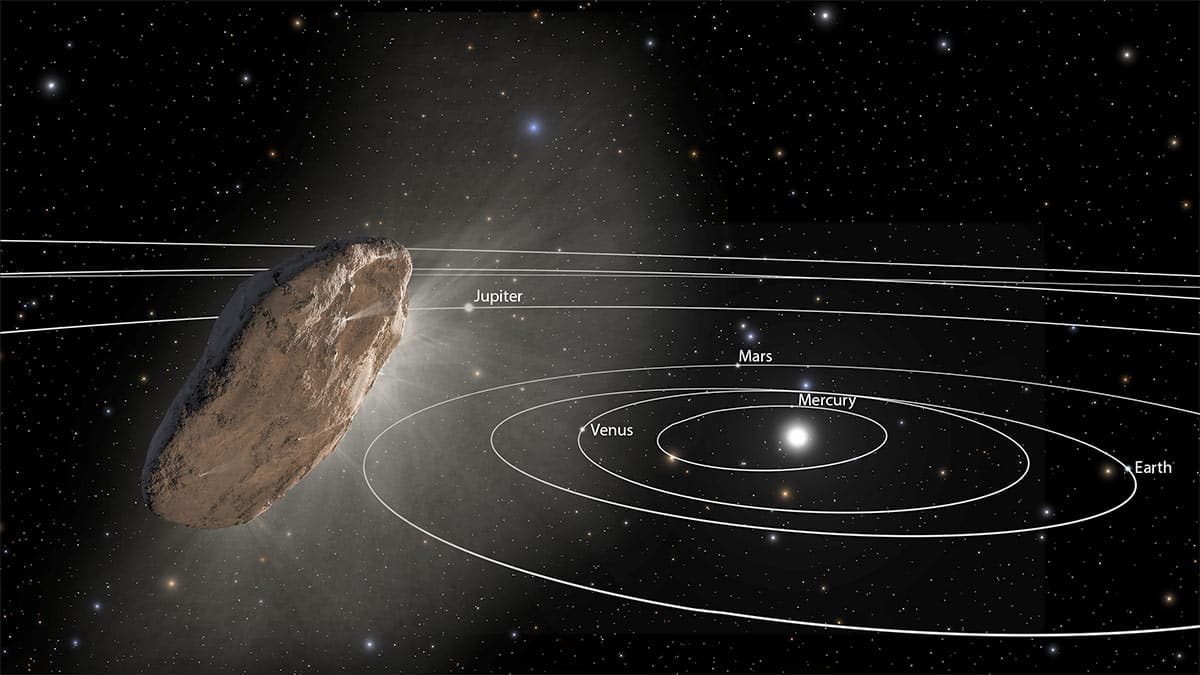What Is A Comet?
A comet is a celestial object that is composed of mainly dust, rocks, water ice, and frozen gases. They are often referred to as ‘dirty snowballs‘ because of their composition, made of material left over from the formation of our solar system.
They are relatively small objects with highly elliptical orbits, spending most of their time in the distant reaches of our solar system.
It can take hundreds, even thousands of years for these objects to complete their orbit. But they do venture into the inner parts of our solar system as they approach the Sun.
Comets can vary in brightness, as their comas and tails reflect sunlight or glow due to absorbed energy. Some are bright enough to be visible to the naked eye, while others are faint and require a telescope for observation.
The “Green Comet “from 2023, formally known as C/2022 E3 ZTF.
Characteristics of a Comet
Each one processes the same characteristics:
- Nucleus: at the core is the nucleus, which is a mixture of water ice, frozen gases, dust, and rock. It is a few kilometers in diameter and is considered the central part of the comet.
- Tails: each one has two types of tails because the gas and dust are influenced by sunlight in different ways. A dust tail, which is composed of small dust particles, and an ion tail, which is made of charged particles. Both tails point away from the Sun and get longer as the comet approaches the Sun.
- Coma: heat causes the solid ice within the nucleus to turn into gas through sublimation when it approaches the Sun. This creates a hazy/glowing type cloud around the nucleus, known as the coma. Along with the tail, this is what gives a comet its distinctive appearance.

Where Do Comets Come From?
They are considered some of the most primitive and ancient objects in the solar system dating back 4.6 million years.
According to NASA, Gerard Kuiper theorized that a belt of ice particles existed beyond Neptune. It is here where icy objects are sometimes nudged into orbit via gravity bring them closer to the Sun.
These are considered short-period comets, taking less than 200 years to complete their orbit of the Sun. In some cases, these comets could even be predicted by scientists based on their previous appearances.
There are also long-period comets that arrive from a farther region referred to as the Oort Cloud. This region is so far away that it can take comets from this region 30 million years to complete their orbit around the Sun.
Comet Tempel 1 Impact. NASA/JPL-Caltech/UMD.
“This spectacular image of comet Tempel 1 was taken 67 seconds after it obliterated Deep Impact’s impactor spacecraft.” NASA Solar System Navigation.
When Are Comets Visible?
As mentioned, these objects spend most of their time in the outer part of the solar system in the Oort Cloud or Kuiper Belt, only coming close to the Sun every few thousand or million years.
They are most easily visible when they get close to the Sun and the ice particles on the surface turn to gas form. This creates a cloud of gas and dust to form around the nucleus of the comet, making it much easier to see.
The tail will grow as the comet gets warmer, which can end up being millions of kilometers long making it easier to see.
Difference Between Comets and Asteroids
They are both planetary objects found in the early history of our solar system that orbit the Sun. However, the main difference between the two is their composition.
An asteroid is typically found in the asteroid belt between Mars and Jupiter. They are small, rocky objects that can be found in a variety of different shapes and sizes.
This is different from a comet which is made of ice and dust which vaporizes as it gets closer to the Sun.
Comets can also leave a trail of debris behind them that can lead to meteor showers on Earth. For instance, the Perseid meteor shower occurs every year between August 9 and 13 when Earth passes through the orbit of Comet Swift-Tuttle.
Interstellar visitor `Oumuamua’ racing toward the outskirts of our solar system. NASA, ESA, and J. Olmsted and F. Summers (STScI).
Famous Comets
Comets are named after the people who discovered them, and include other details such as the type of orbit and year of discovery. Here are some of the more famous ones:
- Comet Halley: perhaps the most famous, it was named after Sir Edmund Halley who predicted it would return. Its sightings and history has been well documented and it returns to the inner solar system roughly every 76 years.
- Comet Shoemaker-Levy 9: famous for its collision with Jupiter in 1994. It broke apart into fragments which impacted Jupiter over several days. It provided valuable insights into the dynamics of comets.
- Comet Hale-Boop: one of the most widely observed comets in the 20th century. It was visible for 18 months from 2995 – 1997 and was able to be seen with the naked eye, generating lots of public interest.
- Comet NEOWISE: discovered by a NASA space telescope, it was visible in July 2020. Many people were interested in seeing and photographing the comet and was a beautiful sight in the night sky.
These events have left their mark on in astronomy and the general public awareness due to their impressive appearances.
Tips for Photographing a Comet
Some of the most recent comets highlighted in the media include C/2022 E3 ZTF (2023) and Neowise (2020). Many people were eager to see and even photograph these objects.
If you are preparing to photograph a comet, there are a few things you’ll want to keep in mind:
- Decide on your composition: You can track the comet itself with a star-trailed background or capture the motion of the stars, and the comet will be blurred. Unlike a typical deep-sky object, they are moving independently from one another.
- Tracking: For the ultimate portrait, you’ll definitely want your telescope to track the COMET – this will allow you to take a clear, long-exposure shot. You may want to stick to shorter subs tracking the stars and stack the image.
- Use the correct stacking mode: The stacking process is a bit different for comets. There are comet-stacking modes in both DeepSkyStacker and PixInsight. Try both to see which one delivers the best result.
- Get Creative: Many people like to create an animated timelapse of the comet traveling through the stars. This is an interesting effect because you can see how fast it’s actually moving through space.
Get a more detailed breakdown of how I photographed Comet C/2022 E3 ZTF.


